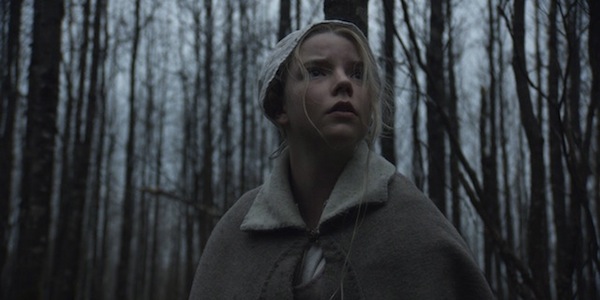Perhaps the most impressive aspect of Robert Eggers‘ The Witch is its unwillingness to pander to its audience. Though people may have been expecting a semi-typical supernatural horror film (complete with jumpscares and excessive gore), what they receive instead is something much more disturbing in its implications. Set in Puritan era New England, The Witch is an atmospherically driven, religion-coated film that is, at times, both beautiful and terrifying.
Dark and Brooding
The Witch focuses on a single Puritan family in rural New England in the 17th century. Cast out by their village due to allegations of excessive pride, they settle on the outskirts of a forest to resume their farming lifestyle. The family consists of patriarchal head William (Ralph Ineson), wife Katherine (Kate Dickie), daughter Thomasin (Anya Taylor-Joy), son Caleb, twins Mercy and Jonas, and baby Samuel. One day while Thomasin is playing peekaboo with Samuel, he suddenly disappears before her eyes, and after days of searching, is presumed dead.

The haunting and alluring tone of The Witch is almost immediately present from the first opening images, where we glimpse the dark, brooding woods lurking just outside the family’s home. “There is evil in the wood,” as we know by William’s own words, but exactly what kind of evil is not immediately obvious. That is, until baby Samuel disappears, and what follows is amongst the more horrifying film sequences that I have seen in some time. It is now clear: this is not a film to be taken lightly.
Yet, after easily the most disturbing scene of the film, Eggers turns almost immediately back to the simple Puritan life, which goes on as usual despite the setback of losing a child. Much of Eggers‘ film is based on this all-too-underused premise: that implications are sometimes much more disturbing than clear, obviously terrifying images. At one point, the parents discuss how lucky they are to have lost only one child, due to not having lost any thus far. To so plainly discuss something that we would typically think of as deeply disheartening is a scary concept indeed.
Much of The Witch drones on at this pace, with one frightening image juxtaposed with a scene of family life, such as the frequent images of William simply chopping away at a pile of wood. This constant breaking away is somehow more unnerving than anything else we could have seen, due to the idea that life goes on around you even with such evil always bubbling beneath the surface.
The Puritan Life
Eggers also chose to linger heavily on the strictly religious lifestyle of this typical Puritan family, where nearly every conversation comes back to their devotion to God, and the idea of sin is greater than any hardship they can endure. After all, William’s family is cast off by their village for religious reasons, and so the importance of daily reverence is even more important as a result.
As the head of the family, William attempts to instill this reverence in every member of his family, with a special emphasis on Thomasin as the eldest child. The scenes between the two often make for some of the more captivating scenes of The Witch, with both Ralph Ineson and Anya Taylor-Joy easily giving the film’s best performances. Ineson in particular, with his deep gruff voice and speaking in the Puritan dialect, almost seems to have been yanked right from that era, while Taylor-Joy is a young but talented actress with much to give.
There are times, though, when The Witch gets even too heavy-handed, especially during some dialogue rich scenes between family members. The religious insinuations become too front-and-center, which unfortunately makes the film appear almost parodic of its subject. Luckily, there are only a few instances where this occurs, as a majority of it is more ideally balanced.
A Folk Tale
The conclusion of The Witch explains that the film is based on folk tales of the time, which would have been written as scary stories to tell around the fire, usually meant to scare straight those who would otherwise stray from their self-disciplined religious lifestyle. They were literal warnings to those who would even consider living their life outside of a strict reverence and devotion to God.
Viewed from this light, it’s easy to see why Eggers made many of the choices he did in his film, such as the decision to not blatantly show the satanic aspects of it from the start. Satanism and evil are always lurking just outside the Puritan’s field of vision, and despite their alluring prospects, it’s up to them to resist its urge. By having such a strict and unwavering way of life, though, the idea of complete freedom is even more enticing. And perhaps this is what The Witch seems to be conveying more than anything else.
Conclusion
The Witch is an exceptional horror film precisely because there are few films to compare it to. It may be underwhelming to those looking for an outright frightening film as opposed to its more stylistic approach, yet there is much to admire about it. If you allow yourself to be caught up in The Witch‘s mesmerizing tone, it can be a truly satisfying (if also unsettling) cinematic experience.
So what did you think of The Witch? What are some of your favorite recent horror films?
Does content like this matter to you?
Become a Member and support film journalism. Unlock access to all of Film Inquiry`s great articles. Join a community of like-minded readers who are passionate about cinema - get access to our private members Network, give back to independent filmmakers, and more.